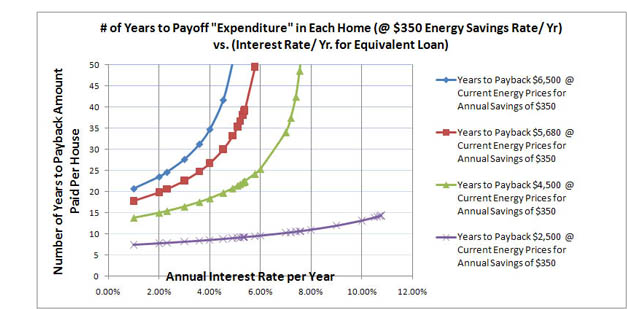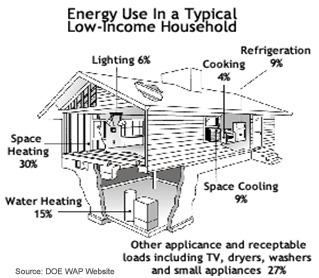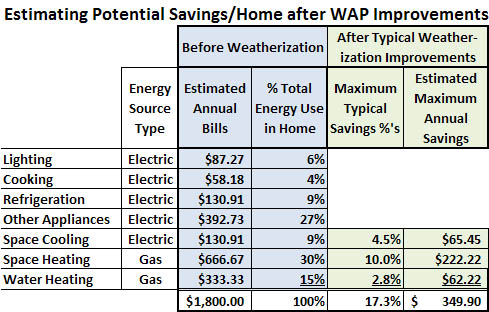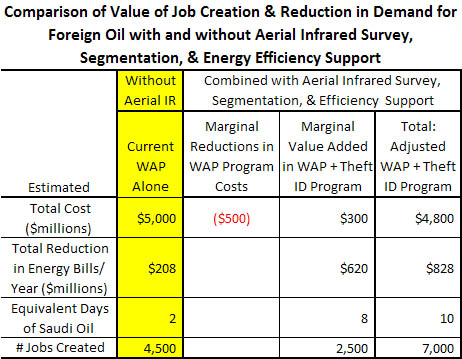RecoverIR™ Blog
Discussion of Discovery & Recovery of Lost Energy
Which is Better for Job Creation and Reducing Dependence on Foreign Oil? Weatherization or Stopping Energy Thieves?
Published by R. G. Lucas in Weatherization • 1/10/2011 8:42:33 PM
Why not do both? We can more efficiently deploy our weatherization dollars and more efficiently identify energy thieves, using the same fully integrated, bench-marking, high resolution, ortho-rectified, fully integrated aerial infrared images and analyses to improve the efficiency of the Weatherization Assistance Program (WAP), reduce costs of the planned “expenditures” per house, and look for natural gas theft at the same time.
Sometimes improvements do not have to be an “either or” proposition. Many, including President Obama and T. Boone Pickens, are pushing to reduce our dependency on foreign oil. The question remains “How?” and here is one answer.
If America can use a growing supply of natural gas more efficiently, then many current uses of oil can be shifted to natural gas. We can shift busses, taxis, electricity generation, etc. to natural gas and reduce our use and demand for foreign oil.
Unless the Creation of Short Term Jobs is the Only Goal of Weatherization Assistance Program (WAP), the Way our Weatherization Assistance Program as Currently Structured is Not a Good Deal for the U.S. Tax Payer!

If the average DOE projected “expenditure”/ payout per home of $6,500 is not reduced by at least 13% to $5,680, it will take more than 30 years for the program to payback the American Tax payers, if we assumed our government had to borrow money at the 27 January 2010, 30 Year Treasury Bond yield rate of 4.53%. At higher historically interest rates above 4.53% with DOE projected WAP average energy savings rates of $350 per year per house, it would make better economic sense to simply give every one of the estimated 593,000 home occupants $350 per year, saving American tax payers $792.45 million per year for the first five years, and the savings from the first five years would almost pay for the annual $207.55 million payment to these 593,000 in perpetuity (nearly forever without inflation).
We have intentionally not discussed Davis-Bacon issues, fraud, and abuse in this article to stay focused on how we can combine two goals with one technical approach to improve both. These issues and others will be discussed in separate blog articles in the future. We are aware of the importance of these other issues.
When the WAP estimated expenditure was $2,500 per home before it was raised to $6,500 the “expenditure” (or payout) to the low income home owner could be effectively recovered through energy savings in less than 10 years. (See x’d purple line on graph)
If the total cost per WAP house is lowered below $5,680 per house (i.e. program can be made more efficient and the return on the “expenditure” would take 30 years), America can both create weatherization jobs and lower our dependency on oil some!
DOE Estimates of Energy Consumption in Low Income House

Assuming “space heating” amounts to 30% of the energy used in a home (value from the DOE WAP website), assuming natural gas costs a consumer $11 per Mcf and the WAP projected energy savings of $350 per home for the WAP targeted number of 593,000 low income homes, the goal for the current WAP program savings amount to the equivalent of $207.6 million in reduced energy bills/ year, (assuming for simplicity each house and water heater are heated with natural gas) a saving of 15,333.9 MMcf of natural gas (an amount thermally equivalent to 2,643,776 barrels of oil or a little less than the amount of oil Saudi Arabia ships to us in a little over two days!).

According to the 2008 U.S. Census Bureau data there are approximately 62 million housing units (residences) in the top 20 energy consuming states with high unemployment, poverty and unemployment (Michigan, Illinois , Ohio, New Jersey, Indiana, New York, Colorado, Pennsylvania, Tennessee, Wisconsin, Massachusetts, Missouri, Minnesota, Maryland, Virginia, Kentucky, Oklahoma, Kansas, Connecticut, and DC). By comparison the 593,000 home number described in the WAP would represent less than 1% of the homes in these just these top 20 energy consuming states, and less than ½ % of all residences in the U.S.
If the U.S. found only 1% natural gas thieves (and we believe >5% theft identification on average is achievable) in the same top 20 energy consuming states with high unemployment, poverty and unemployment, stealing an average of $1,000 per year of gas, the reduction in energy bills would be $620 million per year that could go to reduction of energy bills, a reduction of 56,363.6 MMcf of natural gas consumption (an amount thermally equivalent to 9,717,868 barrels of oil or a little less than the amount of oil Saudi Arabia ships to us in 8-10 days!). It should also be noted the numbers are probably higher because those stealing gas have no incentive to conserve energy, weatherize their homes, and keep doors or windows closed.

So What Can We Accomplish by Combining Programs to Improve (1) How We Prequalify Optimal Weatherization Assistance Program (WAP) Target Homes to Select the “Low Hanging Fruit) & (2) How We Identify Energy Thieves?
By combining the best of the current WAP with large area, high resolution Aerial Infrared Surveys and Analysis the following objectives can be achieved or substantially improved:
>> Ensure tax dollars are more efficiently spent;
>> Segment and focus WAP efforts on the most needy homes first, and perhaps not spend any money on audits for houses which are either well insulated or nearly ready to fall down;
>> Free up WAP dollars through more efficient WAP programs to free dollars to allow expansion of energy savings in both poor and middle class homes;
>> Create more jobs which create more skilled workers for longer careers;
>> Measure, prevent, measure, detect and reduce fraud;
>> Minimize the wholesale replacement of windows in homes, by selectively replacing only the windows on the weather beaten side of homes.
The goals of this article are consistent with President Obama’s 2010 State of the Union Message where he described, * A vision for a clean energy economy. “…to create more of these clean energy jobs, we need more production, more efficiency, and more incentives.” We will build on the historic $80 billion investment made through the Recovery Act. The President’s vision includes investments in important technologies to … reduce our dependence on foreign oil…”
Using fully integrated, bench-marking, high resolution, ortho-rectified, aerial infrared images to improve the efficiency of the WAP, reduce costs of the planned “expenditures” per house, and look for natural gas theft at the same time, are consistent with America’s needs and the directives of the President.

Sometimes improvements do not have to be an “either or” proposition. Many, including President Obama and T. Boone Pickens, are pushing to reduce our dependency on foreign oil. The question remains “How?” and here is one answer.
If America can use a growing supply of natural gas more efficiently, then many current uses of oil can be shifted to natural gas. We can shift busses, taxis, electricity generation, etc. to natural gas and reduce our use and demand for foreign oil.
Unless the Creation of Short Term Jobs is the Only Goal of Weatherization Assistance Program (WAP), the Way our Weatherization Assistance Program as Currently Structured is Not a Good Deal for the U.S. Tax Payer!

If the average DOE projected “expenditure”/ payout per home of $6,500 is not reduced by at least 13% to $5,680, it will take more than 30 years for the program to payback the American Tax payers, if we assumed our government had to borrow money at the 27 January 2010, 30 Year Treasury Bond yield rate of 4.53%. At higher historically interest rates above 4.53% with DOE projected WAP average energy savings rates of $350 per year per house, it would make better economic sense to simply give every one of the estimated 593,000 home occupants $350 per year, saving American tax payers $792.45 million per year for the first five years, and the savings from the first five years would almost pay for the annual $207.55 million payment to these 593,000 in perpetuity (nearly forever without inflation).
We have intentionally not discussed Davis-Bacon issues, fraud, and abuse in this article to stay focused on how we can combine two goals with one technical approach to improve both. These issues and others will be discussed in separate blog articles in the future. We are aware of the importance of these other issues.
When the WAP estimated expenditure was $2,500 per home before it was raised to $6,500 the “expenditure” (or payout) to the low income home owner could be effectively recovered through energy savings in less than 10 years. (See x’d purple line on graph)
If the total cost per WAP house is lowered below $5,680 per house (i.e. program can be made more efficient and the return on the “expenditure” would take 30 years), America can both create weatherization jobs and lower our dependency on oil some!
DOE Estimates of Energy Consumption in Low Income House

Assuming “space heating” amounts to 30% of the energy used in a home (value from the DOE WAP website), assuming natural gas costs a consumer $11 per Mcf and the WAP projected energy savings of $350 per home for the WAP targeted number of 593,000 low income homes, the goal for the current WAP program savings amount to the equivalent of $207.6 million in reduced energy bills/ year, (assuming for simplicity each house and water heater are heated with natural gas) a saving of 15,333.9 MMcf of natural gas (an amount thermally equivalent to 2,643,776 barrels of oil or a little less than the amount of oil Saudi Arabia ships to us in a little over two days!).

According to the 2008 U.S. Census Bureau data there are approximately 62 million housing units (residences) in the top 20 energy consuming states with high unemployment, poverty and unemployment (Michigan, Illinois , Ohio, New Jersey, Indiana, New York, Colorado, Pennsylvania, Tennessee, Wisconsin, Massachusetts, Missouri, Minnesota, Maryland, Virginia, Kentucky, Oklahoma, Kansas, Connecticut, and DC). By comparison the 593,000 home number described in the WAP would represent less than 1% of the homes in these just these top 20 energy consuming states, and less than ½ % of all residences in the U.S.
If the U.S. found only 1% natural gas thieves (and we believe >5% theft identification on average is achievable) in the same top 20 energy consuming states with high unemployment, poverty and unemployment, stealing an average of $1,000 per year of gas, the reduction in energy bills would be $620 million per year that could go to reduction of energy bills, a reduction of 56,363.6 MMcf of natural gas consumption (an amount thermally equivalent to 9,717,868 barrels of oil or a little less than the amount of oil Saudi Arabia ships to us in 8-10 days!). It should also be noted the numbers are probably higher because those stealing gas have no incentive to conserve energy, weatherize their homes, and keep doors or windows closed.

So What Can We Accomplish by Combining Programs to Improve (1) How We Prequalify Optimal Weatherization Assistance Program (WAP) Target Homes to Select the “Low Hanging Fruit) & (2) How We Identify Energy Thieves?
By combining the best of the current WAP with large area, high resolution Aerial Infrared Surveys and Analysis the following objectives can be achieved or substantially improved:
>> Ensure tax dollars are more efficiently spent;
>> Segment and focus WAP efforts on the most needy homes first, and perhaps not spend any money on audits for houses which are either well insulated or nearly ready to fall down;
>> Free up WAP dollars through more efficient WAP programs to free dollars to allow expansion of energy savings in both poor and middle class homes;
>> Create more jobs which create more skilled workers for longer careers;
>> Measure, prevent, measure, detect and reduce fraud;
>> Minimize the wholesale replacement of windows in homes, by selectively replacing only the windows on the weather beaten side of homes.
The goals of this article are consistent with President Obama’s 2010 State of the Union Message where he described, * A vision for a clean energy economy. “…to create more of these clean energy jobs, we need more production, more efficiency, and more incentives.” We will build on the historic $80 billion investment made through the Recovery Act. The President’s vision includes investments in important technologies to … reduce our dependence on foreign oil…”
Using fully integrated, bench-marking, high resolution, ortho-rectified, aerial infrared images to improve the efficiency of the WAP, reduce costs of the planned “expenditures” per house, and look for natural gas theft at the same time, are consistent with America’s needs and the directives of the President.
Recent posts
Does a Big DOE Loan Guarantee Lower Investor/Owner Solar Investment Risk?Landlord charged with tapping UGI lines, stealing gas
What will Happen to Natural Gas Prices in Ohio when the OCC's Budget is Cut in Half
Two Metrics to Monitor the President's Weatherization Assistance Program Waste
Are the Bill Paying Electricity and Natural Gas Residential Customers in Pennsylvania being Cheated?
All the posts...